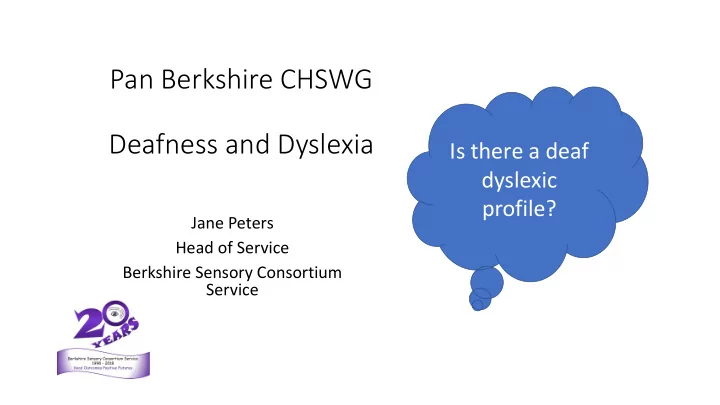

Pan Berkshire CHSWG Deafness and Dyslexia Is there a deaf dyslexic profile? Jane Peters Head of Service Berkshire Sensory Consortium Service
“Dyslexia is a specific learning difficulty that mainly affects the development of literacy and language related skills. It is likely to be present at birth and to be life-long in its effects. It is characterised by difficulties with: • phonological processing • rapid naming • working memory • processing speed Skills usually don’t match up to an individual’s other cognitive abilities.
Misconceptions Each person is Dyslexia just unique in the way affects reading they experience and writing. the condition
Signs of Dyslexia - Early Years •Struggles to name •Mispronounces words, familiar objects or names •Has difficulty learning •Has trouble remembering like saying “beddy tear” of people and uses general nursery rhymes or song sequences, like singing the instead of “teddy bear” or words like ‘thing’ and lyrics that rhyme letters of the alphabet ‘cubumber or ‘flutterby’ ‘stuff’ instead •Has difficulty •Tells stories that are hard remembering and to follow; has trouble Difficulty in dressing eg Poor auditory following two or more talking about an event in a shoe laces and buttons discrimination directions with multiple logical order steps
Signs of Dyslexia - Primary •Often confuses letters •Has trouble learning •Struggles to read familiar •Substitutes words when that look similar (b, d, p, Spelling that’s letter names and words (like cat or the), reading aloud, like saying q) and letters with similar unpredicatable and remembering the sounds especially if there aren’t house when the story says sounds (d/t; b/p; f/v), also inconsistent they make pictures home numbers 6 instead of 9 •Has trouble hearing the •Has trouble Speed of reading, writing individual sounds in remembering how words Poor handwriting is very slow words and blending are spelled and applying sounds to make a word spelling rules in writing
•Confuses or skips small words like for and of when reading aloud Struggles to learn sequences such as days of the week, months of the year •Has trouble sounding out new words and quickly recognizing common ones •Struggles to explain what happened in a story or answer questions about key details •Avoids reading whenever possible or gets frustrated or upset when reading • Poor standard of written work compared with oral ability Lack of expression in reading and poor comprehension
•Reads slowly, leaving out small words and parts of longer words when reading aloud •Struggles to remember common abbreviations, including ones on social media •Often seems to be searching for words; may use substitutes like Signs of gate instead of fence Dyslexia in •Often doesn’t “get” the joke; has trouble understanding idioms and puns Teens •Has an easier time answering questions about a page of text if it’s read aloud •Takes a very long time to complete reading assignments • Difficulty with taking notes in lesson
• Attainment data highlights the significant gap between hearing and deaf CYP in terms of reading and writing. • Research tells us deaf CYP have difficulties with phonological awareness • How do we differentiate deaf CYP who are poor readers due to limited exposure to pre reading experiences from those who are dyslexic • No tests available and no normative data for CYP who are deaf
Research Herman, Roy & Kyle, 2014 and 2017 Reading and dyslexia in deaf children 2 phase study 10-11yr olds (all severe or profoundly deaf) Questions • What measures can be used to identify dyslexia in deaf children? Does this differ between communication preferences • Are deaf children’s reading difficulties similar to the typical dyslexic profile, or do some deaf children display uniquely dyslexic profiles? • What are the key factors associated with good and poor reading in this group? • What are the implications for interventions with poor deaf readers?
Tests (those used with hearing CYP plus additional targeted areas relating to reading and deafness • Nonverbal skills • Literacy skills (letter-sound knowledge, single word & non-word reading, reading comprehension, spelling) • Phonological skills • Naming speed (pictures and digits • Fluency (semantic and rhyme) skills • Language skills (expressive vocabulary; BSL skills) • Speech intelligibility • Speechreading skills • Sequential organisation skills
Findings • Overall literacy scores were below age related expectations (ARE) • 48% of the oral group below ARE • 82% of the signing group below ARE • Small group of signing YP whose parents were both deaf who achieved the same level as the oral cohort • Spelling was better than reading for both groups • No deaf poor reader fit the classic dyslexic profile of weak phonological skills and average language • Key role of vocabulary in deaf children’s literacy skills (and Language)
Practical Suggestions • Following diagnosis – do we ask if there is a history of dyslexia in the family. • More emphasis on nursery rhymes – encourage rhythm and rhyme • Lots of auditory memory games • Developing kinaesetic awareness – tracking shapes and letter ,words, pictures with eyes closed • Playing games like what’s in the bag • Reading lots of books and using the language of books – pictures, words, letters, front of the book, cover, top of the page
Implications • Greater focus on vocabulary building • Speech discrimination skills • Development of phonological awareness – beyond phonics! • Auditory memory and sequencing
Recommend
More recommend